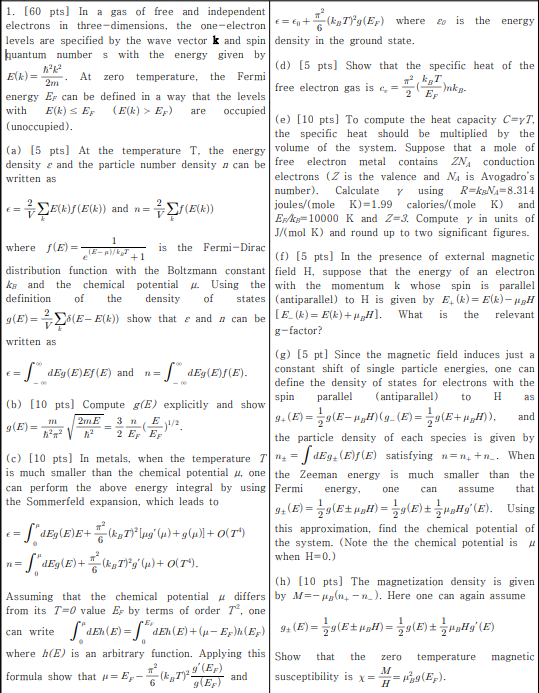(Solved): [60 pts] In a gas of free and independent electrons in three-dimensions, the one-electron levels ar ...
[60 pts] In a gas of free and independent electrons in three-dimensions, the one-electron levels are specified by the wave vector
kand spin kuantum number
swith the energy given by
E(k)=(ℏ^(2)k^(2))/(2m). At zero temperature, the Fermi energy
E_(F)can be defined in a way that the levels with
E(k)<=E_(F),(E(k)>E_(F))are occupied (unoccupied). (e) [10 pts] To compute the heat capacity
C=\gamma T, the specific heat should be multiplied by the volume of the system. Suppose that a mole of free electron metal contains
ZN_(A)conduction electrons (
Zis the valence and
N_(A)is Avogadro's number). Calculate
\gamma using
R=k_(B)N_(A)=8.314joules/(mole
,Kcalories/(mole K) and
(E_(F))/(k_(B))=10000Kand
Z=3. Compute
\gamma in units of
(J)/(molK)and round up to two significant figures. (f) [5 pts] In the presence of external magnetic field
H, suppose that the energy of an electron with the momentum
kwhose spin is parallel (antiparallel) to
His given by
E_(+)(k)=E(k)-\mu _(B)H
E_(-)(k)=E(k)+\mu _(B)H. What is the relevant
g-factor? (g) [5 pt] Since the magnetic field induces just a constant shift of single particle energies, one can define the density of states for electrons with the spin parallel (antiparallel) to
Has
g_(+)(E)=(1)/(2)g(E-\mu _(B)H)(g_(-)(E)=(1)/(2)g(E+\mu _(B)H))and the particle density of each species is given by
n_(+-)=\int dEg_(+-)(E)f(E)satisfying
n=n_(+)+n_(-). When the Zeeman energy is much smaller than the Fermi energy, one can assume that
g_(+-)(E)=(1)/(2)g(E+-\mu _(B)H)=(1)/(2)g(E)+-(1)/(2)\mu _(B)Hg^(')(E). Using this approximation, find the chemical potential of the system. (Note the the chemical potential is
\mu when
H=0.) (h) [10 pts] The magnetization density is given by
M=-\mu _(B)(n_(+)-n_(-)).
